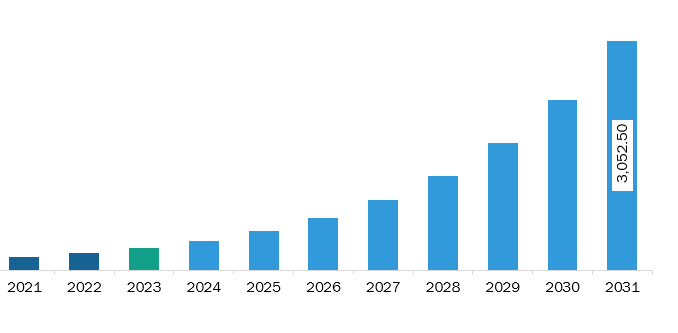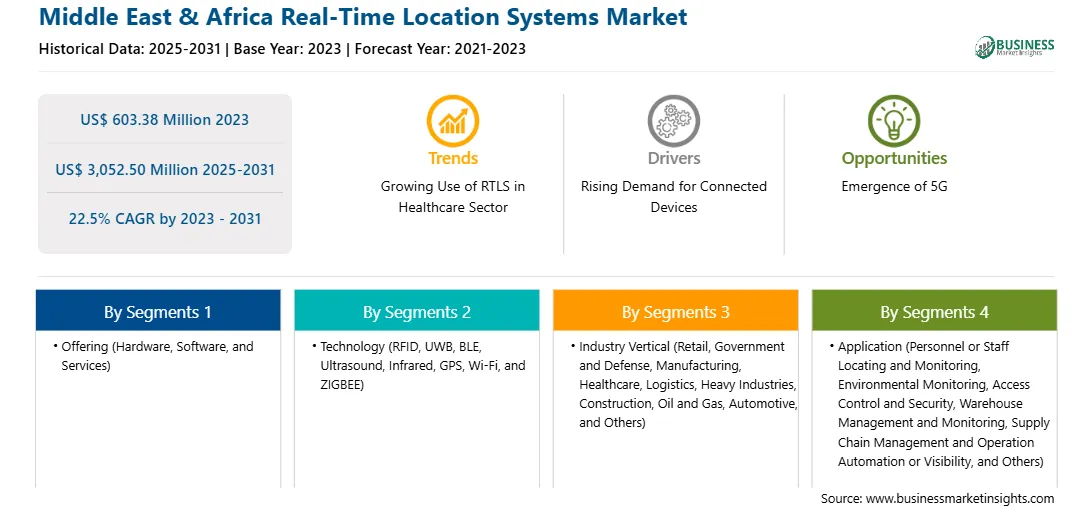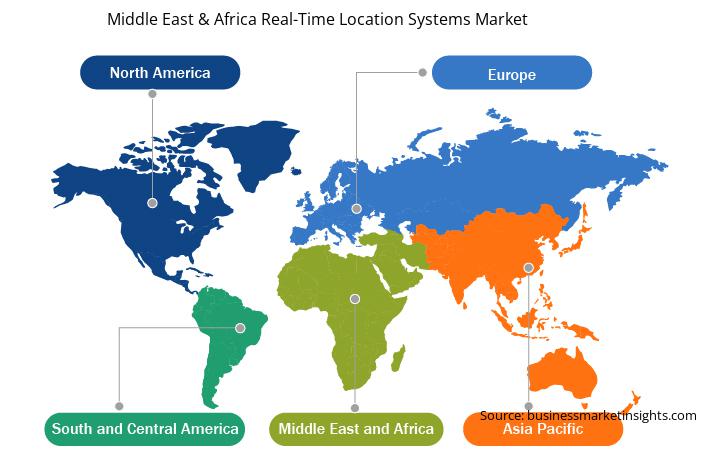The Middle East & Africa real-time location systems market was valued at US$ 603.38 million in 2023 and is expected to reach US$ 3,052.50 million by 2031; it is estimated to register a CAGR of 22.5% from 2023 to 2031.
In the healthcare sector, RTLS is used to maintain patient safety and provide great experience and satisfaction. The technology can assist in tracking patient flow for throughput management, which can further help recognize and address bottlenecks. It can also help find solutions for problems such as long waiting times; overcrowding in emergency rooms, outpatient clinics, and post-anesthesia care units; delay or rescheduling of surgeries; and shortage of beds for patients. RTLS technology is used in everyday operations or emergencies at hospitals to locate hospital assets such as beds, equipment, wheelchairs, and others quickly and reliably. In emergencies and when the hospital is nearing capacity, RTLS can help notify the availability of a bed when a patient is discharged. Through this, hospitals can achieve up to 50% faster bed turnover times. In addition, the technology can assist in keeping track of medical devices such as IV pumps, ICU ventilators, and defibrillators to ensure their availability when needed, thus helping to save the lives of critical patients. Furthermore, by using RTLS, patients or staff members can be tracked. For instance, patients suffering from mental distress who must be watched closely can be easily tracked through RTLS technology if they wander away from their treatment area or into other parts of the facility. The RTLS-embedded solution will send an alert whenever patients cross a virtual boundary into an unauthorized area. It can provide a high level of security to patients and reduce the time of staff members, which should be devoted to directly monitoring these patients. As the RTLS technology can help track assets and patients, its demand is expected to increase in the healthcare sector during the forecast period.
Additionally, SLAM technology could significantly enhance the effectiveness of the RTLS in healthcare. By using SLAM, hospitals can improve the precision of indoor navigation and asset tracking, even in complex environments with limited GPS access. SLAM enables real-time mapping and location tracking, allowing healthcare providers to monitor the movement of patients, staff, and medical equipment more accurately. As SLAM improves the accuracy and reliability of RTLS, its integration into healthcare systems is expected to drive the demand for real-time location tracking solutions, improving patient care and operational efficiency.
The Middle East & Africa real-time location system market is segmented into South Africa, Saudi Arabia, the UAE, and the Rest of MEA. With the rising proliferation of smartphones, coupled with the expansion of internet connectivity across the Middle East, there is a noteworthy increase in online shopping in the region. Additionally, several countries in the MEA have a large internet user base. For instance, according to the Digital 2023: The United Arab Emirates report, in early 2023, there were ~9.38 million internet users in the UAE, indicating a 99.0% internet penetration rate. Similarly, according to the Digital 2023: Saudi Arabia Report, there were 36.31 million Saudi Arabian internet users in 2023 indicating a 99.0% internet penetration. The increase in internet users in the region is expected to fuel the growth of the e-commerce industry in the MEA. According to the International Trade Administration, by 2024, the number of Saudi internet users for e-commerce is expected to reach 33.6 million, an increase of 42% from 2019. According to the Dubai Chamber of Commerce and Industry, the e-commerce industry in the UAE is expected to generate sales of US$ 8 billion by 2025. Furthermore, other countries in the MEA, such as Bahrain, Kuwait, and Qatar, are adopting the e-retail mode of distribution, which is expected to influence the growth of the MEA real-time location system market in the coming years.

Strategic insights for the Middle East & Africa Real-Time Location Systems provides data-driven analysis of the industry landscape, including current trends, key players, and regional nuances. These insights offer actionable recommendations, enabling readers to differentiate themselves from competitors by identifying untapped segments or developing unique value propositions. Leveraging data analytics, these insights help industry players anticipate the market shifts, whether investors, manufacturers, or other stakeholders. A future-oriented perspective is essential, helping stakeholders anticipate market shifts and position themselves for long-term success in this dynamic region. Ultimately, effective strategic insights empower readers to make informed decisions that drive profitability and achieve their business objectives within the market.

| Report Attribute | Details |
|---|---|
| Market size in 2023 | US$ 603.38 Million |
| Market Size by 2031 | US$ 3,052.50 Million |
| CAGR (2023 - 2031) | 22.5% |
| Historical Data | 2021-2023 |
| Forecast period | 2025-2031 |
| Segments Covered |
By Offering
|
| Regions and Countries Covered | Middle East and Africa
|
| Market leaders and key company profiles |
|
The geographic scope of the Middle East & Africa Real-Time Location Systems refers to the specific areas in which a business operates and competes. Understanding local distinctions, such as diverse consumer preferences (e.g., demand for specific plug types or battery backup durations), varying economic conditions, and regulatory environments, is crucial for tailoring strategies to specific markets. Businesses can expand their reach by identifying underserved areas or adapting their offerings to meet local demands. A clear market focus allows for more effective resource allocation, targeted marketing campaigns, and better positioning against local competitors, ultimately driving growth in those targeted areas.

The Middle East & Africa real-time location systems market is categorized into offering, technology, industry vertical, application, and country.
By offerings, the Middle East & Africa real-time location systems market is divided into hardware, software, and services. The hardware segment held the largest share of the Middle East & Africa real-time location systems market share in 2023.
In terms of technology, the Middle East & Africa real-time location systems market is segmented into RFID, UWB, BLE, ultrasound, infrared, GPS, Wi-Fi, and ZIGBEE. The BLE segment held the largest share of the Middle East & Africa real-time location systems market share in 2023.
Based on industry vertical, the Middle East & Africa real-time location systems market is segmented into retail, government and defense, manufacturing, healthcare, logistics, heavy industries, construction, oil and gas, automotive, and others. The healthcare segment held the largest share of the Middle East & Africa real-time location systems market share in 2023.
By application, the Middle East & Africa real-time location systems market is divided into personnel or staff locating and monitoring, environmental monitoring, access control and security, warehouse management and monitoring, supply chain management and operation automation or visibility, and others. The supply chain management and operation automation or visibility segment held the largest share of the Middle East & Africa real-time location systems market share in 2023.
Based on country, the Middle East & Africa real-time location systems market is segmented into South Africa, Saudi Arabia, the UAE, and the Rest of Middle East & Africa. The UAE segment held the largest share of Middle East & Africa real-time location systems market in 2023.
AiRISTA Flow Inc, Aruba Networks, Impinj Inc, Kudan Inc, Microsoft Corp, NavVis GmbH, Qorvo Inc, Sevensense Robotics AG, Siemens AG, Slamcore Ltd, Sonitor Technologies AS, Stanley Black & Decker Inc, TeleTracking Technologies Inc, Ubisense Ltd, and Zebra Technologies Corp are among the leading companies operating in the Middle East & Africa real-time location systems market.
The Middle East & Africa Real-Time Location Systems Market is valued at US$ 603.38 Million in 2023, it is projected to reach US$ 3,052.50 Million by 2031.
As per our report Middle East & Africa Real-Time Location Systems Market, the market size is valued at US$ 603.38 Million in 2023, projecting it to reach US$ 3,052.50 Million by 2031. This translates to a CAGR of approximately 22.5% during the forecast period.
The Middle East & Africa Real-Time Location Systems Market report typically cover these key segments-
The historic period, base year, and forecast period can vary slightly depending on the specific market research report. However, for the Middle East & Africa Real-Time Location Systems Market report:
The Middle East & Africa Real-Time Location Systems Market is populated by several key players, each contributing to its growth and innovation. Some of the major players include:
The Middle East & Africa Real-Time Location Systems Market report is valuable for diverse stakeholders, including:
Essentially, anyone involved in or considering involvement in the Middle East & Africa Real-Time Location Systems Market value chain can benefit from the information contained in a comprehensive market report.